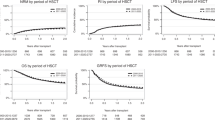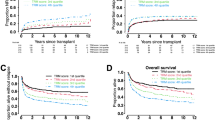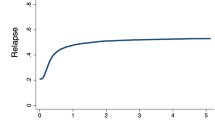Abstract
The outcomes for allogeneic hematopoietic cell transplantation (allo-HCT) are heavily influenced by non-relapse mortality (NRM). We retrospectively assessed the changes in the incidence and causes of NRM after allo-HCT over the past 12 years. NRM, relapse rate and OS were analyzed using the Japan transplant outcome database of 6501 adult patients with acute leukemia or myelodysplastic syndrome who received their first allo-HCT in remission from 1997 through 2008. In multivariate analysis in patients aged 16–49 years, the adjusted hazard ratios (HRs) for NRM for 2001–2004 and 2005–2008 were 0.78 (95% confidence interval, 0.65–0.93) and 0.64 (0.54–0.78), respectively, compared with 1997–2000. The HR for overall mortality in 2005–2008 was 0.81 (0.70–0.93) compared with 1997–2000. In patients aged 50–70 years, the HRs for NRM and overall mortality in 2005–2008 were 0.56 (0.46–0.68) and 0.66 (0.47–0.93), respectively, compared with those in 2001–2004. We found that causes of death that contributed to the changes in NRM varied among subgroups. In conclusion, our study indicated that the incidence of NRM after allo-HCT has significantly decreased over the past 12 years, which has led to an improvement of OS, and also showed reductions in NRM in subgroups consisting of older patients and those who received unrelated cord blood transplantation.
This is a preview of subscription content, access via your institution
Access options
Subscribe to this journal
Receive 12 print issues and online access
$259.00 per year
only $21.58 per issue
Buy this article
- Purchase on Springer Link
- Instant access to full article PDF
Prices may be subject to local taxes which are calculated during checkout




Similar content being viewed by others
References
Gooley TA, Chien JW, Pergam SA, Hingorani S, Sorror ML, Boeckh M et al. Reduced mortality after allogeneic hematopoietic-cell transplantation. N Engl J Med 2010; 363: 2091–2101.
Horan JT, Logan BR, Agovi-Johnson MA, Lazarus HM, Bacigalupo AA, Ballen KK et al. Reducing the risk for transplantation-related mortality after allogeneic hematopoietic cell transplantation: how much progress has been made? J Clin Oncol 2011; 29: 805–813.
Giebel S, Labopin M, Holowiecki J, Labar B, Komarnicki M, Koza V et al. Outcome of HLA-matched related allogeneic hematopoietic stem cell transplantation for patients with acute leukemia in first complete remission treated in Eastern European centers. Better results in recent years. Ann Hematol 2009; 88: 1005–1013.
Gratwohl A, Brand R, Frassoni F, Rocha V, Niederwieser D, Reusser P et al. Cause of death after allogeneic haematopoietic stem cell transplantation (HSCT) in early leukaemias: an EBMT analysis of lethal infectious complications and changes over calendar time. Bone Marrow Transplant 2005; 36: 757–769.
Atsuta Y, Suzuki R, Yoshimi A, Gondo H, Tanaka J, Hiraoka A et al. Unification of hematopoietic stem cell transplantation registries in Japan and establishment of the TRUMP System. Int J Hematol 2007; 86: 269–274.
Giralt S, Ballen K, Rizzo D, Bacigalupo A, Horowitz M, Pasquini M et al. Reduced-intensity conditioning regimen workshop: defining the dose spectrum. Report of a workshop convened by the center for international blood and marrow transplant research. Biol Blood Marrow Transplant 2009; 15: 367–369.
Sorror ML, Maris MB, Storb R, Baron F, Sandmaier BM, Maloney DG et al. Hematopoietic cell transplantation (HCT)-specific comorbidity index: a new tool for risk assessment before allogeneic HCT. Blood 2005; 106: 2912–2919.
Flomenberg N, Baxter-Lowe LA, Confer D, Fernandez-Vina M, Filipovich A, Horowitz M et al. Impact of HLA class I and class II high-resolution matching on outcomes of unrelated donor bone marrow transplantation: HLA-C mismatching is associated with a strong adverse effect on transplantation outcome. Blood 2004; 104: 1923–1930.
Lee SJ, Klein J, Haagenson M, Baxter-Lowe LA, Confer DL, Eapen M et al. High-resolution donor-recipient HLA matching contributes to the success of unrelated donor marrow transplantation. Blood 2007; 110: 4576–4583.
Martin PJ, McDonald GB, Sanders JE, Anasetti C, Appelbaum FR, Deeg HJ et al. Increasingly frequent diagnosis of acute gastrointestinal graft-versus-host disease after allogeneic hematopoietic cell transplantation. Biol Blood Marrow Transplant 2004; 10: 320–327.
Oh H, Loberiza FR, Zhang MJ, Ringden O, Akiyama H, Asai T et al. Comparison of graft-versus-host-disease and survival after HLA-identical sibling bone marrow transplantation in ethnic populations. Blood 2005; 105: 1408–1416.
Hahn T, McCarthy PL, Zhang MJ, Wang D, Arora M, Frangoul H et al. Risk factors for acute graft-versus-host disease after human leukocyte antigen-identical sibling transplants for adults with leukemia. J Clin Oncol 2008; 26: 5728–5734.
Upton A, Kirby KA, Carpenter P, Boeckh M, Marr KA . Invasive aspergillosis following hematopoietic cell transplantation: outcomes and prognostic factors associated with mortality. Clin Infect Dis 2007; 44: 531–540.
Yokoe D, Casper C, Dubberke E, Lee G, Munoz P, Palmore T et al. Infection prevention and control in health-care facilities in which hematopoietic cell transplant recipients are treated. Bone Marrow Transplant 2009; 44: 495–507.
Fukuda T, Boeckh M, Carter RA, Sandmaier BM, Maris MB, Maloney DG et al. Risks and outcomes of invasive fungal infections in recipients of allogeneic hematopoietic stem cell transplants after nonmyeloablative conditioning. Blood 2003; 102: 827–833.
Marr KA, Seidel K, Slavin MA, Bowden RA, Schoch HG, Flowers ME et al. Prolonged fluconazole prophylaxis is associated with persistent protection against candidiasis-related death in allogeneic marrow transplant recipients: long-term follow-up of a randomized, placebo-controlled trial. Blood 2000; 96: 2055–2061.
Paulin T, Ringden O, Nilsson B . Immunological recovery after bone marrow transplantation: role of age, graft-versus-host disease, prednisolone treatment and infections. Bone Marrow Transplant 1987; 1: 317–328.
Sayer HG, Longton G, Bowden R, Pepe M, Storb R . Increased risk of infection in marrow transplant patients receiving methylprednisolone for graft-versus-host disease prevention. Blood 1994; 84: 1328–1332.
Barrett AJ . Conditioning regimens for allogeneic stem cell transplants. Curr Opin Hematol 2000; 7: 339–342.
Feinstein L, Storb R . Reducing transplant toxicity. Curr Opin Hematol 2001; 8: 342–348.
Abou-Mourad YR, Lau BC, Barnett MJ, Forrest DL, Hogge DE, Nantel SH et al. Long-term outcome after allo-SCT: close follow-up on a large cohort treated with myeloablative regimens. Bone Marrow Transplant 2010; 45: 295–302.
Acknowledgements
This work was supported by grants from the Japanese Ministry of Health, Labour and Welfare, and the National Cancer Research and Development Fund (23-A-28). The results were presented at the 52nd Annual Meeting of the American Society of Hematology in Orlando, FL, USA, 7 December 2010.
Author contributions: SK designed the study, prepared the data file, performed the analysis, interpreted the data and wrote the manuscript; KY contributed to the study design, data file preparation, data analysis and interpretation of the data; TY was primarily responsible for the study design, data analysis and interpretation of the data; YA reviewed and cleaned the data, interpreted the data and helped to write the manuscript; TNI reviewed, cleaned and interpreted the data, HA, ST, KM, ST, TE, HO and MK obtained and interpreted the data; JT, KK, KK, RS, YM and HS reviewed, cleaned and interpreted the data; TF designed the study, interpreted the data and helped to write the manuscript.
Author information
Authors and Affiliations
Corresponding author
Ethics declarations
Competing interests
The authors declare no conflict of interest.
Rights and permissions
About this article
Cite this article
Kurosawa, S., Yakushijin, K., Yamaguchi, T. et al. Changes in incidence and causes of non-relapse mortality after allogeneic hematopoietic cell transplantation in patients with acute leukemia/myelodysplastic syndrome: an analysis of the Japan Transplant Outcome Registry. Bone Marrow Transplant 48, 529–536 (2013). https://doi.org/10.1038/bmt.2012.172
Received:
Revised:
Accepted:
Published:
Issue Date:
DOI: https://doi.org/10.1038/bmt.2012.172
Keywords
This article is cited by
-
Should a matched sibling donor still be considered the primary option for allogeneic hematopoietic cell transplantation in patients over 50 years of age with myelodysplastic syndrome?
Bone Marrow Transplantation (2023)
-
Incidence and predictors of recurrent sick leave in survivors who returned to work after allogeneic hematopoietic cell transplantation
Journal of Cancer Survivorship (2023)
-
Pretransplant spleen volume and outcome after hematopoietic stem cell transplantation (HSCT) in patients with acute myeloid leukemia (AML)
Annals of Hematology (2023)
-
Intensive oral care can reduce bloodstream infection with coagulase-negative staphylococci after neutrophil engraftment in allogeneic hematopoietic stem-cell transplantation
Supportive Care in Cancer (2022)
-
Resignation and return to work in patients receiving allogeneic hematopoietic cell transplantation close up
Journal of Cancer Survivorship (2022)



